Cast Iron Hollowware Shapes
Browsing old manufacturers' catalogs reveals there was more to cast iron cookware than just skillets and dutch ovens. Much more. Shapes were produced for most every culinary need, and evolved over time to adapt and conform to new technologies as well as changing consumer needs and tastes.
Early cast iron cookware was designed for use over a fire, and later, at a fireplace hearth. Legs to hold pans above hot coals and long handles to distance the cook from the flame were necessities. The introduction of the wood-burning stove eliminated the need for legs but would prompt other innovations specifically designed for it.
Spiders and Skillets
Early frying pans, with their handles and legs, came to be called "spiders", apparently due to what many considered a resemblance to the arachnid. Griswold would later use the image of a spider with a skillet for a body as one of its company logos.
 | The term "skillet" arrived somewhat later, perhaps after the need for legs had passed, but some continued for a time to refer to the now-legless pans as spiders. There doesn't seem to be a clear cut-off date for the switch in terminology. Some old catalogs even call pans with legs skillets, while others call pans without legs spiders. So it would seem that insisting a particular legless pan be called one or the other is a rather pointless exercise. |
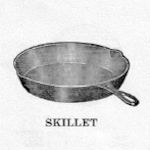 | Regular skillets are those that conform to a generally accepted ratio of depth to diameter. Across all sizes, they are typically 1-1/2 to 2 inches in depth. First sold in nominal sizes 3-14 to conform to various diameter woodstove eyes, the size numbering convention persisted long after the decline of woodstove popularity. Less popular odd sizes like 2, 9, 11 and 13 were phased out over time by most makers. The enormous size 20 was a loop-handled "hotel" skillet. |
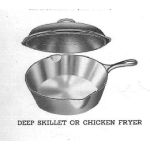 | Deep skillets were typically confined to sizes 7 through 12, with 8 and 10 being the most popular, and are usually between 2-1/2 and 3 inches in depth. When supplied with self-basting lids, they doubled as roasters. Also known as chicken fryers, they are seen with and without pour lips. |
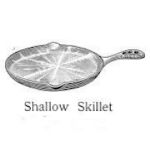 | Shallow skillets were of moderate popularity, and provided the convenience of being able to turn foods with a spatula more easily than with a deeper pan. Economy brand skillets were less deep than regular skillets, but they are not considered a shallow skillet. |
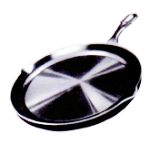 | Greaseless frying skillets fell between skillets and handle griddles. With a trough around the circumference, excess grease could be channeled away from the cooking food. |
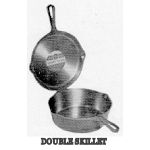 | Double skillets were merely regular or deep skillets supplied with a flat topped, handled cover that could also be inverted to serve as a skillet or griddle. |
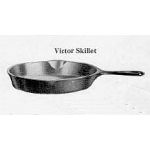 | Economy brand skillets were produced to achieve a lower price point. Generally limited to sizes 7, 8 and 9, they are slightly smaller in diameter and shallower than regular skillets of the same size number. Griswold, Wagner, Favorite and Wapak made Victor, National, Miami and Oneta economy skillets, respectively. |
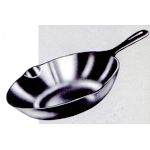 | Chef's skillets were relative latecomers to skillet shapes, with curved walls and usually an upswept handle to facilitate saute. |
Pots and Kettles
Although seemingly the most basic of cookware, pots and kettles came in various shapes to better serve a variety of common needs.
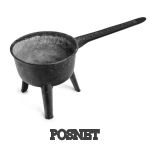 | Among the earliest of cast iron cookpot designs, the posnet was quite common in the late 18th century. Having three legs, splayed wide for added stability, and a long handle, posnets were more a footed saucepan than a frying pan. Some variation in the shape is seen, with some more flat-bottomed than rounded. Pans with shallower depths, wider diameters and sometimes rims are often seen incorrectly referred to as posnets. |
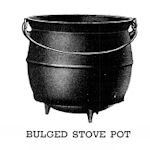 | Footed kettles and pots were used over a fire or at a kitchen hearth. As cooking moved to wood stoves, no longer-needed legs disappeared in favor of flat bottoms, heat rings or pit bottoms. |
 | Flat bottom kettles need little explanation. With bail handles and a pouring assist ring attached midway down one side, they were suited to a variety of uses on the stovetop. Versions in different depths, simply dubbed "high" and "low" were offered. Versions with a rim modified to accept a locking lid with a pouring strainer became "safety kettles". |
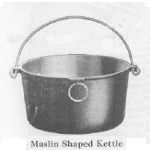 | Maslin kettles were intended for cooking grains as for porridge or oatmeal. Wide at the top to facilitate evaporation, they were equipped with bail handles and a pouring assist ring attached at the rim. Rather than stove eye numbers, they were designated in quarts, typically 4, 6, 8 and 12. |
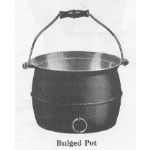 | Bulged kettles came in low, high, flat-bottomed, pit-bottomed and eccentric versions. It has been said that, if early frontier settlers had but one cast iron utensil, it would have been a bulged kettle. |
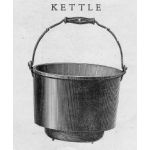 | Pit Bottom kettles had a reduced diameter bottom well designed to drop into a stove eye rather than sit atop it, presumably to increase heating efficiency.
Eccentric kettles were simply pit bottom kettles whose bottom well was off-center. This allowed the bottom well to sit in the stove eye while the kettle itself could be rotated nearer to the edge of the stovetop thus allowing more room for other pieces to be set comfortably over adjacent stove eyes. |
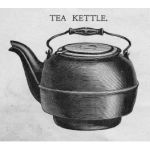 | Tea kettles in iron were mostly confined to a few standard shapes, and either flat- or pit-bottomed. Sometimes, small, nubby feet are seen as a measure to prevent rocking on a bottom gatemark. Bail handles evolved from forged iron to wood-insulated to plated, heat-dissipating coiled. |
Boilers
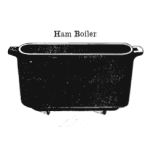 | Stove top boilers, for cooking, seem to be confined to just one: the ham boiler. A large elongated oval vessel, it could easily hold a whole bone-in ham and be positioned over two stove eyes or burners. They are seen footed, and in both pit and flat bottom styles. |
| Ovens & Roasters
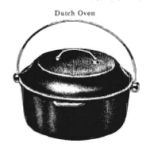 | Dutch ovens are a medium depth round pot with a tight fitting lid joint designed to minimize moisture loss over a long, slow cook. So-called not because they hail from Holland, but rather because the meaning of "dutch" as used here was likely derived from the term "dutch gold", an alloy of copper and zinc used to make an imitation gold leaf. Today, we might equate it with the term "faux". An alternate term seen used for these is a "round roaster". They can be used either in the oven or on the stovetop. |
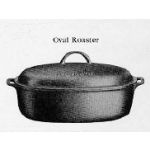 | Oval roasters are merely an enlarged version, made with a turkey, goose, or large joint of meat in mind. |
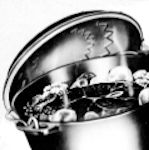 | Basting lids came into vogue for roasters in the 1920s after a Griswold employee noted a feature of a sanitary steam cooker patented a few years earlier could be adapted to roaster lids. Raised elements on the underside of the lid redirected condensation back down onto the cooking food instead of to the rim of the lid where it might only run down the inside wall of the pot. (Or the outside if the lid joint and pot rim had not been ground to meet flush.) Competitors devised their own versions using zigzag rings, spikes or dimples. |
Bowls
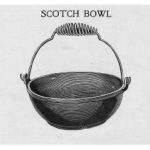 | Scotch bowls were hemispherical, ring-footed to prevent wobbling, and designed to cook food requiring constant stirring. As there was no angle between sidewall and bottom, there was no place for food to accumulate and be missed by the stirring utensil. Scotch bowls were also handy for deep frying. |
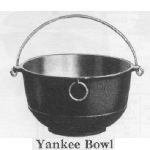 | Yankee bowls are like Scotch bowls, just deeper. |
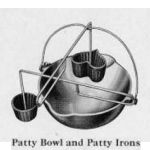 | Patty bowls were essentially mini-deep fryers. Used with patty, "rosette" or "timbale" irons, oil was heated in them to cook a batter the irons were dipped in, creating decoratively-shaped "patty shells" to be filled with a variety of sweet or savory preparations. |
Griddles
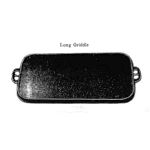 | Long griddles, as their name suggests, were typically 18" to two feet in length and 8 to 10 inches in width, often with a grease channel around the perimeter and perhaps a small collection well at one end. Handles on both ends were either loops or tabs. |
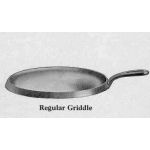 | Round griddles first appeared as essentially very shallow skillets. Over time the design changed to a more or less flat disk that allowed unobstructed spatula access. Each style was seen both side handled and bailed. |
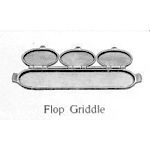 | Flop griddles were somewhat of a novelty. Three or four shallow round pans were connected with hinges along the long side of a narrow long griddle. Pancake batter was poured into each of the pans and allowed to cook briefly before being "flopped over" onto the long griddle side without having to use a spatula. Returned to their original position, the hinged pans could then be refilled while the previous batch finished. |
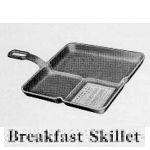 | Specialty breakfast griddles, or breakfast skillets, enjoyed a degree of popularity, even if they were a bit impractical. Designed with shallow compartments shaped to fit eggs, bacon or toast, the idea was that all your breakfast items could be cooked in the same pan. A timing strategy was likely necessary to avoid undercooked bacon or overcooked eggs. They are seen in square and round configurations. |
Bakeware
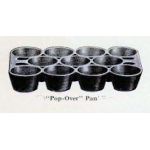 | Gem and Muffin pans were made in myriad shapes and configurations. Gems were Graham flour biscuits often filled with fruit or jam. Typical gem pans make 10 to 12. Muffin pans had usually either 6 or 12 cups. See Gem & Muffin Pans for more. |
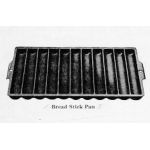 | Stick pans had either plain, long narrow cups for breadsticks or decorative impressions to create corn cob or wheat kernel shapes. |
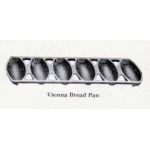 | Roll & Bread pans made loaves, pistolets and dinner rolls. |
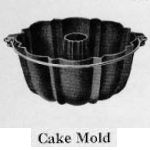 | Bundt cake pans made the classic cake shape. Pans had either tab, loop or sometimes bail handles. |
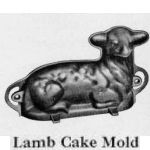 | Novelty shapes for special occasion cakes included lambs, rabbits, and Santa Claus. These were comprised of two parts, a front and a back. Batter would be poured into one half and the other half set in place on top. During baking the cake would rise to fill the top half, resulting in a complete figure. |
Stovetop Utensils
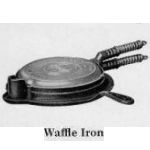 | Waffle irons enjoyed enormous popularity, up to and through the advent of gas-fired stovetops. Beyond several sizes of round waffle makers, irons making heart-shaped and square waffles were also seen. |
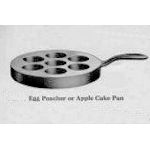 | Aebelskiver pans, with their seven hemispherical cups, were used to make the popover pastry of the same name, which translated means "apple slices". The pans were also marketed as egg poachers. |
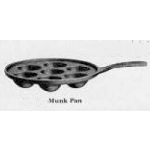 | Munk pans were essentially also aebelskiver pans, but without the thick encircling rim. Alternately seen called monk pans. |
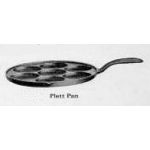 | Plett pans, handled griddles with seven shallow round indentations, were used to make the popular small Swedish pancakes. |
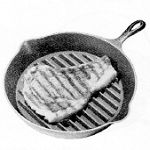 | Broilers evolved from grating units set in place across two woodstove eyes and round, handled pans that fit a single eye. Eventually, skillets with a series of raised bars across the cooking surface replaced them after woodstoves went out of use. |
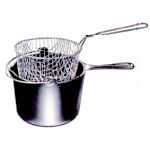 | French fryers were like tall saucepans with an additional bail handle and were supplied with baskets for deep frying. |
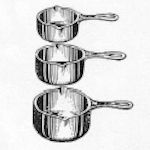 | Sauce pans in cast iron are seen, but by far, more sizes and variations were produced in aluminum. |
Heaters
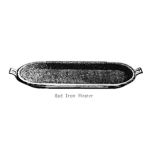 | Sad Iron heaters were typically elongated oval pans set across two woodstove eyes. Other types included pyramidal-shaped holders that allowed multiple irons to be leaned vertically against their faces, over a single round stove eye. As their need for use as heaters waned, they were seen marketed as "long pans" or "fish pans". |
Camp Ware
Camp ware pieces are generally large, to serve a crowd; thick and heavy, to retain heat; and made with legs for use over a campfire. |
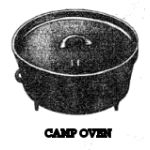 | Camp ovens were used for baking and roasting. With their flanged covers, hot coals could be added on top for more even cooking. Made in several sizes, they also came in shallow, deep and extra deep versions. |
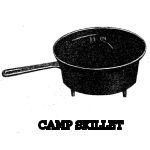 | Camp skillets were used for frying and general pan cooking. If deep enough, and with a cover, they could also serve as roasting or baking ovens. |
The foregoing were not the only shapes made. Various others were produced over the decades by the major manufacturers, among them were:
- Divided skillets
- Oval skillets
- Square skillets
- Odorless skillets and kettles
- Bailed skillets
- Stew pans
- Wafer irons
- Baking pans and dishes
- Large format pieces e.g. sugar kettles, cauldrons

















































